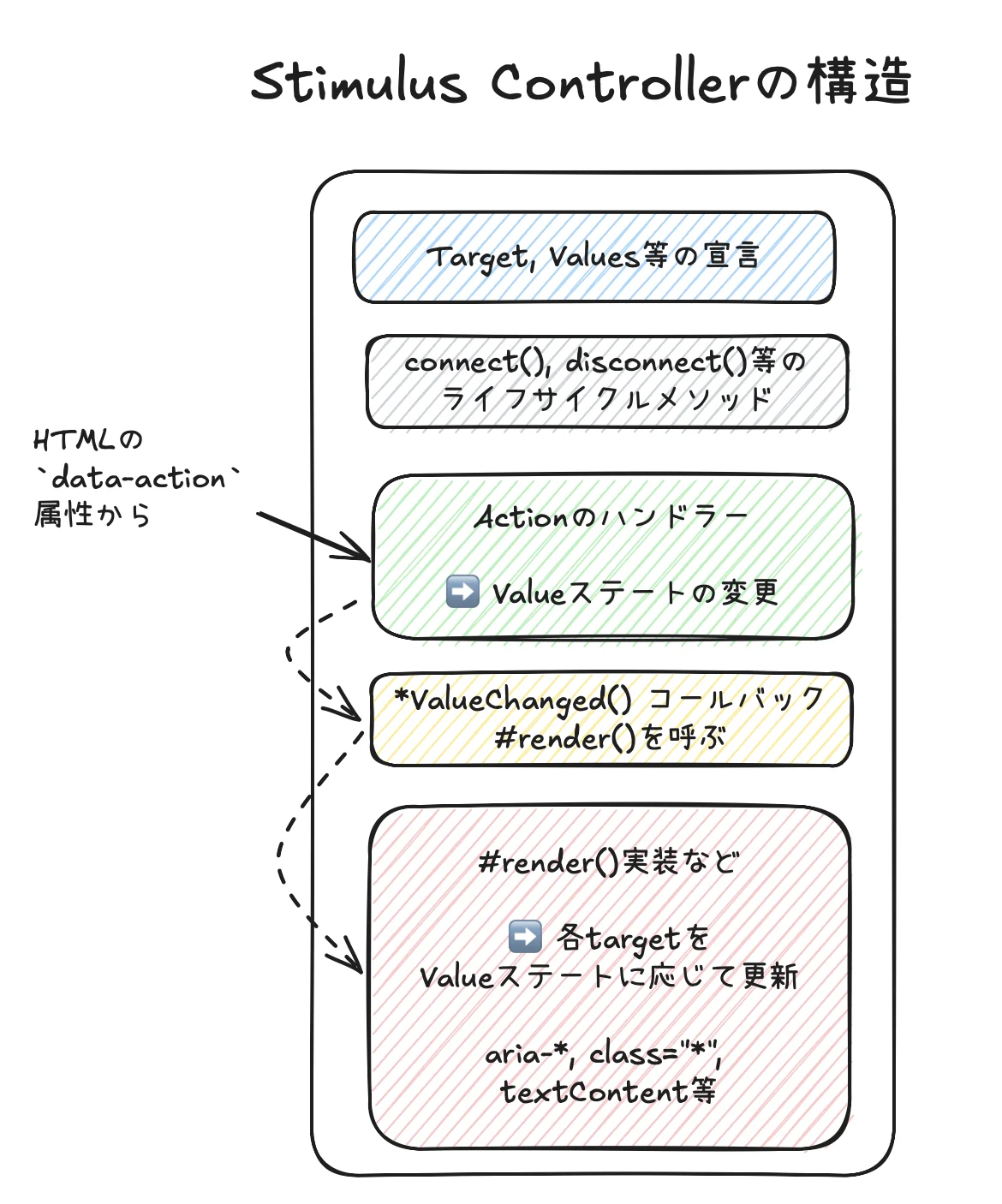コンセプト
Stimulus Controllerの構造
はじめに
ここでは私がStimulus Controllerを書くときのパターンを紹介します。他人のものとの比較は十分にやっているわけではありませんが、概ね似ているのではないかと思います。
単方向データフロー
Reactが普及させた単方向データフローはロジックがわかりやすく、デバッグしやすいのが特徴です。特に複数のActionが複数のTargetを更新しているケースではロジックが追いやすくなります。
複雑なステートを管理する場合、Stimulusも単方向データフロー的な使い方ができます。ここで紹介するのはこのようなものです。簡単なステートの場合は、ここまで考える必要はありません。
コード例の中には下記の書き方をしているものがたくさんあります。
- 簡単な例: 引き出しの例
- 複雑な例: Apple Store模写の例
具体例
下記はApple Store模写の比較的複雑なStimulus Controllerの例です。各セクションをコメントしていますので、コードの中をご確認ください。
- 私はActionのメソッドの行数を少なくして、RailsのThin Controllerのようにしています。ステートの更新に集中させることで、責務を明確にします(ただしステートを介さないような簡単な処理の場合は直接targetを更新させます)。
- ActionハンドラーとRenderを明確に分けるのは大きなメリットがあると感じています。
- また下記では
IPhoneクラスを用意し、ビジネスロジックは完全に分離収納しています。下記のような処理の流れになります。- Actionで
this.iphoneValueステートを更新する(Valuesステート) #render()するとき、上記ステートでIPhoneクラスを初期化IPhoneクラスのビジネスロジックに応じて、画面を変更する
- Actionで
import {Controller} from "@hotwired/stimulus" import IPhone from "../models/IPhone" // Connects to data-controller="iphone-static" export default class extends Controller { // target, values, classes, outlets等の宣言 static targets = [ "image", "price", "colorText", "itemPricing", "modelForm", "colorForm", "ramForm" ] static values = { catalogData: Object, iphone: {type: Object, default: {model: null, color: null, ram: null}} } // Stimulus Controllerを使うときは真っ先に接続確認をしますので、たいてい残しています。 // ここに`alert("hello")`などと書いて、接続を確認します。 connect() { } // `data-action`によって呼び出されるイベントハンドラ群。 // Actionと読んだりもします。 // Actionはなるべく行数を少なくします。RailsのThin Controllerと同じ発想で、 // なるべく他のメソッドに処理を委任します。 // // 簡単な場合はActionの中でHTMLのCSS属性やちょっとした内容を変更しますが、 // 多くの場合はステートを変更するのにとどめます。ステートに基づいて実際に // HTMLを変更するのは、複雑になってきたらなるべく`#render()`のようなもので // まとめて処理します。 updateOption(event) { const {name, value} = event.currentTarget this.iphoneValue = {...this.iphoneValue, [name]: value} } updateColor(event) { const color = event.currentTarget.value this.iphoneValue = {...this.iphoneValue, color: color} } // この2つのActionはステートを介さないような簡単な処理をする箇所です。 // そのためにActionの中で直接targetを更新しています。 setColorText(event) { const colorName = event.params.colorName const colorFullName = this.catalogDataValue.colors[colorName].full_name this.colorTextTargets.forEach(target => target.textContent = colorFullName) } resetColorText(event) { this.colorTextTargets.forEach(target => target.textContent = this.iphone.fullColorName()) } // Stimulus `Values`でステートを管理している場合は、Valueが変更されたら自動的に // 呼び出される`*ValueChanged`コールバックを使います。 iphoneValueChanged() { this.#render() } // 少し複雑になって、複数のtargetを更新するControllerの場合は、すべてまとめて // #render()に記載します。 // // なおActionによってはすべてのtargetを更新する必要がないものもあります。 // しかし、どのActionがどのtargetを更新するかを管理するのは大変です。 // 多少の無駄があっても、常にすべてのtargetを更新するように私はしています。 // これは差分検出処理がないだけで、割とReactの考え方に近いのではないかと思います。 #render() { // このStimulus Controllerではステートマシン的な管理や価格計算が行われています。 // Controllerにそのロジックを入れるとかなり大きくなってしまうので、 // 別途 `Iphone` モデルを作って使用しています。 // あくまでもControllerは **Action ==> Valuesなどのステート ==> targets** の // フローを管理するものとして切り分けます。 this.iphone = new IPhone(this.iphoneValue, this.catalogDataValue) this.#renderImageTarget() this.#renderPriceTarget() this.#renderColorTextTargets() this.#renderItemPricingTargets() this.#renderFormTargets() } // targetごとにレンダリングするメソッドを分けます #renderImageTarget() { this.imageTarget.src = this.iphone.imagePath() } #renderPriceTarget() { const price = this.iphone.price() this.priceTarget.textContent = `From ${price.lump.toFixed(2)} or ${price.monthly.toFixed(2)}` } #renderColorTextTargets() { const colorText = this.iphone.fullColorName() this.colorTextTargets.forEach(e => e.textContent = colorText) } #renderItemPricingTargets() { this.itemPricingTargets.forEach(e => { const name = e.dataset.iphoneStaticPricingName const value = e.dataset.iphoneStaticPricingValue const pricing = name === "model" ? this.iphone.pricingFor(value, this.iphone.ram) : this.iphone.pricingFor(this.iphone.model, value) e.innerHTML = ` <div class="text-xs text-gray-500 text-right">From \$${pricing.lump.toFixed(2)}</div> <div class="text-xs text-gray-500 text-right">or \$${pricing.monthly.toFixed(2)}</div> <div class="text-xs text-gray-500 text-right">for 24 mo.</div> ` }) } #renderFormTargets() { this.modelFormTarget.disabled = !this.iphone.canEnterModel() this.colorFormTarget.disabled = !this.iphone.canEnterColor() this.ramFormTarget.disabled = !this.iphone.canEnterRam() } }
まとめ
- 簡単な場合はStimulus Controllerはどのように書いても整理ができます
- しかしある程度複雑になると、Reactの単方向データフローと同じように、データフローを整理した方がわかりやすくなります。StimulusはそのためのValuesステートを用意しています
